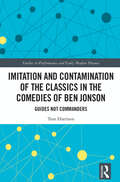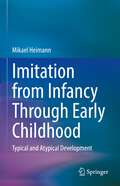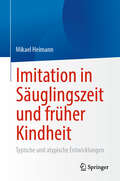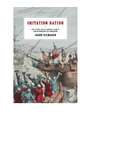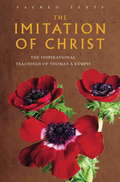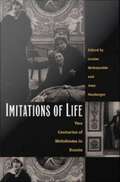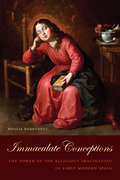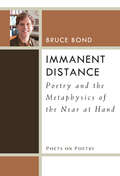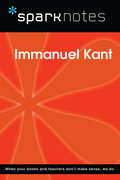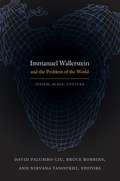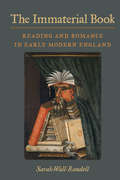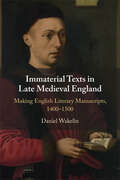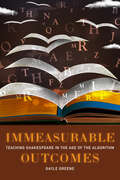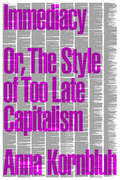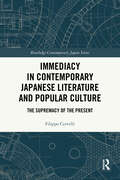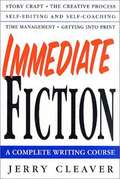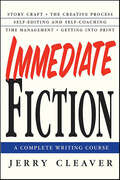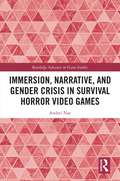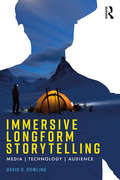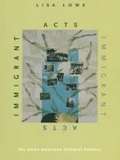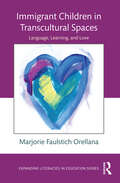- Table View
- List View
Imitation and Contamination of the Classics in the Comedies of Ben Jonson: Guides Not Commanders (Studies in Performance and Early Modern Drama)
by Tom HarrisonThis book focuses on the influence of classical authors on Ben Jonson’s dramaturgy, with particular emphasis on the Greek and Roman playwrights and satirists. This book illuminates the interdependence of the aspects of Jonson’s creative personality by considering how classical performance elements including the Aristophanic ‘Great Idea,’ chorus, Terentian/Plautine performative strategies, and ‘performative’ elements from literary satire manifest themselves in the structuring and staging of his plays. This fascinating exploration contributes to the ‘performative turn’ in early modern studies by reframing Jonson’s classicism as essential to his dramaturgy as well as his erudition. This book is also a case study for how the early modern education system’s emphasis on imitative-contaminative practices prepared its students, many of whom became professional playwrights, for writing for a theatre that had a similar emphasis on the recycling and recombining performative tropes and structures.
Imitation and Praise in the Poems of Ben Jonson
by Richard S. PetersonIn the first edition of this now-classic text, Richard Peterson offered an important revaluation of the poetry of Ben Jonson and a new appreciation of the way in which the classical doctrine of imitation-the creative use of the thoughts and words of predecessors-permeates and shapes Jonson's critical ideas and his work as a whole. The publication of the original book in 1981 led to a reinterpretation of the poems and a coherent view of Jonson's philosophy; the resulting portrait of Jonson served as a corrective to earlier views based primarily on the satiric poems and plays. This second edition of Imitation and Praise in the Poems of Ben Jonson makes Peterson's important scholarship available to a new generation of scholars and students.
Imitation from Infancy Through Early Childhood: Typical and Atypical Development
by Mikael HeimannThis book summarizes more than four decades of research on imitation in infancy and its relation to early learning and sociocognitive development in typically and atypically developing children. The studies were carried out in a Scandinavian context and thus provide important cultural validation of the central developmental processes. The book is divided into three parts: Part one focuses on the social and cognitive aspects of imitation, discussing links to early parent-infant interaction, and developmental meaning. It addresses evidence for an imitative capacity at birth for typical and atypical infants. Also covered are early individual differences in imitation, the role of imitation as a social and cognitive learning mechanism in early development, and possible links between imitation and temperament. Part two presents unique longitudinal studies on early memory development using deferred imitation as the key method. It discusses the biological basis of memory and explores the idea that deferred imitation is an indicator of an infant’s ability to understand intentions. Part three focuses on imitation in young children with autism and with Down syndrome. It examines the role of imitation as a “deficit” as well as a vehicle for change when used interactively in early interventions for children with autism. Imitation from Infancy Through Early Childhood is an essential resource for researchers, professors, and graduate students as well as clinicians and other professionals in developmental psychology, cognitive development, psycholinguistics, child psychiatry, and developmental neuroscience.
Imitation in Säuglingszeit und früher Kindheit: Typische und atypische Entwicklungen
by Mikael HeimannDieses Buch fasst mehr als vier Jahrzehnte Forschung zur Imitation in der Säuglingszeit und deren Zusammenhang mit frühem Lernen und soziokognitiver Entwicklung bei typischen und atypischen Kindern zusammen. Die Studien wurden in einem skandinavischen Kontext durchgeführt und bieten somit eine wichtige kulturelle Validierung der zentralen Entwicklungsprozesse. Das Buch ist in drei Teile gegliedert: Teil eins konzentriert sich auf die sozialen und kognitiven Aspekte der Imitation und diskutiert die Verbindungen zur frühen Interaktion zwischen Eltern und Säuglingen sowie deren Entwicklungsbedeutung. Es wird Beweise für eine Imitationsfähigkeit bei der Geburt für typische und atypische Säuglinge erörtert. Auch frühe individuelle Unterschiede in der Imitation, die Rolle der Imitation als sozialer und kognitiver Lernmechanismus in der frühen Entwicklung und mögliche Verbindungen zwischen Imitation und Temperament werden behandelt. Teil zwei präsentiert einzigartige längsschnittliche Studien zur frühen Gedächtnisentwicklung, wobei die aufgeschobene Imitation als Schlüsselmethodik verwendet wird. Es wird die biologische Grundlage des Gedächtnisses diskutiert und die Idee erforscht, dass aufgeschobene Imitation ein Indikator für die Fähigkeit eines Säuglings ist, Absichten zu verstehen. Teil drei konzentriert sich auf die Imitation bei jungen Kindern mit Autismus und Down-Syndrom. Es wird die Rolle der Imitation als „Defizit“ sowie als Mittel für Veränderungen untersucht, wenn sie interaktiv in frühen Interventionen für Kinder mit Autismus eingesetzt wird. Dieses Buch ist eine unverzichtbare Ressource für ForscherInnen, ProfessorInnen und DoktorandInnen sowie für KlinikerInnen und andere Fachleute in der Entwicklungspsychologie, kognitiven Entwicklung, Psycholinguistik, Kinderpsychiatrie und Entwicklungsneurowissenschaft.
Imitation Nation: Red, White, and Blackface in Early and Antebellum US Literature
by Jason RichardsHow did early Americans define themselves? The American exceptionalist perspective tells us that the young republic rejected Europeans, Native Americans, and African Americans in order to isolate a national culture and a white national identity. Imitativeness at this time was often seen as antithetical to self and national creation, but Jason Richards argues that imitation was in fact central to such creation. Imitation Nation shows how whites simultaneously imitated and therefore absorbed the cultures they so readily disavowed, as well as how Indians and blacks emulated the power and privilege of whiteness while they mocked and resisted white authority.By examining the republic’s foundational literature--including works by Washington Irving, James Fenimore Cooper, Harriet Beecher Stowe, Herman Melville, and Martin Delany--Richards argues that the national desire for cultural uniqueness and racial purity was in constant conflict with the national need to imitate the racial and cultural other for self-definition. The book offers a new model for understanding the ways in which the nation’s identity and literature took shape during the early phases of the American republic.
The Imitation of Christ
by Stephan MackennaThe saintly Thomas à Kempis's classic guide to the spiritual and religious life. A book which has been loved and revered by devout Christians throughout the ages. Transcending all sectarian divisions, it emphasises the importance of the inward journey.
The Imitation of Christ
by Stephan MackennaThe saintly Thomas à Kempis's classic guide to the spiritual and religious life. A book which has been loved and revered by devout Christians throughout the ages. Transcending all sectarian divisions, it emphasises the importance of the inward journey.
The Imitation of Christ
by Stephan MackennaThe saintly Thomas à Kempis's classic guide to the spiritual and religious life. A book which has been loved and revered by devout Christians throughout the ages. Transcending all sectarian divisions, it emphasises the importance of the inward journey.
Imitations of Life: Two Centuries of Melodrama in Russia
by Louise Mcreynolds Joan NeubergerImitations of Life views Russian melodrama from the eighteenth century to today as an unexpectedly hospitable forum for considering social issues. The contributors follow the evolution of the genre through a variety of cultural practices and changing political scenarios. They argue that Russian audiences have found a particular type of comfort in this mode of entertainment that invites them to respond emotionally rather than politically to social turmoil. Drawing on a wide variety of sources, including plays, lachrymose novels, popular movies, and even highly publicized funerals and political trials, the essays in Imitations of Life argue that melodrama has consistently offered models of behavior for times of transition, and that contemporary televised versions of melodrama continue to help Russians cope with national events that they understand implicitly but are not yet able to articulate. In contrast to previous studies, this collection argues for a reading that takes into account the subtle but pointed challenges to national politics and to gender and class hierarchies made in melodramatic works from both the nineteenth and twentieth centuries. Collectively, the contributors shift and cross borders, illustrating how the cultural dismissal of melodrama as fundamentally escapist and targeted primarily at the politically disenfranchised has subverted the drama's own intrinsically subversive virtues. Imitations of Life will interest students and scholars of contemporary Russia, and Russian history, literature, and theater. Contributors. Otto Boele, Julie Buckler, Julie Cassiday, Susan Costanzo, Helena Goscilo, Beth Holmgren, Lars Lih, Louise McReynolds, Joan Neuberger, Alexander Prokhorov, Richard Stites
Immaculate Conceptions: The Power of the Religious Imagination in Early Modern Spain (Toronto Iberic)
by Rosalie HernandezImmaculate Conceptions examines devotional writings, religious and literary texts, and visual art that feature the mystery of the immaculacy of the Virgin Mary in the culture of early modern Spain. The author’s analysis is motivated by the complexity and multivalent capacity of the doctrine and its icon at a time when the debates around Mary’s conception imbued all levels of religious and social life. She considers the many interests – political, doctrinal, artistic, and gender-driven – that intersect and compete in the exegesis and textual and visual representations of the Immaculate Conception. She argues that the Immaculate Conception of Mary proved to be a fertile conceptual and ideological field wherein the identities of the Spanish state, local communities, and individuals were negotiated, variously defined, and contested. The study’s broader aim is to delineate a speculative category, the religious imagination, defined as a spiritual, intellectual, or artistic pursuit in which the individual is committed to sacred truth yet articulates this truth through contingent, partial, and contextually determined theological propositions. The representational status of the image and its relationship to theories of physical sight and spiritual vision are central to the author’s formulation of this category.
Immanent Distance: Poetry And The Metaphysics Of The Near At Hand
by Bruce BondIn these essays, Bruce Bond interrogates the commonly accepted notion that all poetry since modernism tends toward one of two traditions: that of a more architectural sensibility with its resistance to metaphysics, and that of a latter-day Romantic sensibility, which finds its authority in a metaphysics authenticated by the individual imagination. Poetry, whether self-consciously or not, has always thrived on the paradox of the distant in the immanent and the other in the self; as such, it is driven by both a metaphysical hunger and a resistance to metaphysical certainty. Hidden resources of being animate the language of the near, just as near things beckon from an elusive and inarticulate distance. Bond revalidates the role of poetry and, more broadly, of the poetic imagination as both models for and embodiments of a transfigurative process, an imperfectly mimetic yet ontological engendering of consciousness at the limits of a language that must--if cognizant of its psychological, ethical, and epistemological summons--honor that which lies beyond it.
Immanuel Kant (SparkNotes Philosophy Guide)
by SparkNotesImmanuel Kant (SparkNotes Philosophy Guide) Making the reading experience fun! Created by Harvard students for students everywhere, SparkNotes is a new breed of study guide: smarter, better, faster. Geared to what today's students need to know, SparkNotes provide:Chapter-by-chapter analysis Explanations of key themes, motifs, and symbols A review quiz and essay topics Lively and accessible, these guides are perfect for late-night studying and writing papers.
Immanuel Wallerstein and the Problem of the World: System, Scale, Culture
by David Palumbo-Liu Bruce Robbins Nirvana TanoukhiIn this collection of essays, leading cultural theorists consider the meaning and implications of world-scale humanist scholarship by engaging with Immanuel Wallerstein's world-systems analysis. The renowned sociologist developed his influential critical framework to explain the historical and continuing exploitation of the rest of the world by the West. World-systems analysis reflects Wallerstein's conviction that understanding global inequality requires thinking on a global scale. Humanists have often criticized his theory as insufficiently attentive to values and objects of knowledge such as culture, agency, difference, subjectivity, and the local. The editors of this collection do not deny the validity of those criticisms; instead, they offer Wallerstein's world-systems analysis as a well-developed vision of the world scale for humanists to think with and against. Scholars of comparative literature, gender, geography, history, law, race, and sociology consider what thinking on the world scale might mean for particular disciplinary practices, knowledge formations, and objects of study. Several essays offer broader reflections on what is at stake for the study of culture in decisions to adopt or reject world-scale thinking. In a brief essay, Immanuel Wallerstein situates world-systems analysis vis--vis the humanities. Contributors. Gopal Balakrishnan, Tani E. Barlow, Neil Brenner, Richard E. Lee, Franco Moretti, David Palumbo-Liu, Bruce Robbins, Helen Stacy, Nirvana Tanoukhi, Immanuel Wallerstein, Kren Wigen
The Immaterial Book: Reading and Romance in Early Modern England
by Sarah Wall-RandellIn romances--Renaissance England's version of the fantasy novel--characters often discover books that turn out to be magical or prophetic, and to offer insights into their readers' selves. The Immaterial Book examines scenes of reading in important romance texts across genres: Spenser's Faerie Queene, Shakespeare's Cymbeline and The Tempest, Wroth's Urania, and Cervantes' Don Quixote. It offers a response to "material book studies" by calling for a new focus on imaginary or "immaterial" books and argues that early modern romance authors, rather than replicating contemporary reading practices within their texts, are reviving ancient and medieval ideas of the book as a conceptual framework, which they use to investigate urgent, new ideas about the self and the self-conscious mind.
Immaterial Texts in Late Medieval England: Making English Literary Manuscripts, 1400–1500
by Daniel WakelinDaniel Wakelin introduces and reinterprets the misunderstood and overlooked craft practices, cultural conventions and literary attitudes involved in making some of the most important manuscripts in late medieval English literature. In doing so he overturns how we view the role of scribes, showing how they ignored or concealed irregular and damaged parchment; ruled pages from habit and convention more than necessity; decorated the division of the text into pages or worried that it would harm reading; abandoned annotations to poetry, focusing on the poem itself; and copied English poems meticulously, in reverence for an abstract idea of the text. Scribes' interest in immaterial ideas and texts suggests their subtle thinking as craftspeople, in ways that contrast and extend current interpretations of late medieval literary culture, 'material texts' and the power of materials. For students, researchers and librarians, this book offers revelatory perspectives on the activities of late medieval scribes.
Immeasurable Outcomes: Teaching Shakespeare in the Age of the Algorithm
by Gayle GreeneWhat is the purpose of education? The answer might be found in a Shakespeare class at a small liberal arts college.In this engaging account of teaching a Shakespeare class at a small liberal arts college, Gayle Greene illustrates what is so vital and urgent about the humanities. Follow along with Greene as she introduces us to her students and showcases their strengths, needs, and vulnerabilities, so we can experience the magic of her classroom. In Immeasurable Outcomes, Greene's class builds a complex human ecosystem that pushes students to think more deeply and discover their own interests and potential, all while recognizing the inherent dignity in other people's views and values. Grounding her analyses in half a century of teaching, Greene pushes back against the demand for measurable student learning outcomes and the standardization imposed on K-12 schools in the name of reform. Instead, she draws her conclusions about education directly from the students themselves. Alumni testimonials describe the transformative power of a liberal arts education, recounting how their experience of community and engagement has provided them the tools to navigate the uncertainties of a rapidly changing world while also inspiring the social awareness our democracy depends on. Immeasurable Outcomes rejects claims that the liberal arts are impractical, exposing the political agendas of technocrats and ideologues who would transform higher education into vocational training and programs focused only on profitability. Greene reminds us that the liberal arts have been the basis for the most successful educational system in the world and provides a powerful demonstration that education at a human scale that is relationship-rich and humanities-based should be the model for education in the future.
Immediacy: Or, The Style of Too Late Capitalism
by Anna KornbluhWhy speed, flow, and direct expression now dominate cultural styleContemporary cultural style boosts transparency and instantaneity. These are values absorbed from our current economic conditions of "disintermediation": cutting out the middleman. Like Uber, but for art. Immediacy names this style to make sense of what we lose when the contradictions of twenty-first-century capitalism demand that aesthetics negate mediation. Surging realness as an aesthetic program synchs with the economic imperative to intensify circulation when production stagnates. "Flow" is the ultimate twenty-first-century buzzword, but speedy circulation grinds art down to the nub. And the bad news is that political turmoil and social challenges require more mediation. Collective will, inspiring ideas, and deliberate construction are the only way out, but our dominant style forgoes them. Considering original streaming TV, popular literature, artworld trends, and academic theories, Immediacy explains the recent obsession with immersion and today&’s intolerance of representation, and points to alternative forms in photography, TV, novels, and constructive theory that prioritize distance, impersonality, and big ideas instead.
Immediacy in Contemporary Japanese Literature and Popular Culture: The Supremacy of the Present (Routledge Contemporary Japan Series)
by Filippo CervelliThis book analyzes the theme of immediacy and the supremacy of the present in contemporary Japanese fiction.Examining immediacy in literary works by a diverse body of authors and works in popular culture released during the major social and economic changes of 1995 and the triple disaster of March 2011, the book underlines the importance of the perception of instability crucial for immediacy. By recontextualizing varied narratives of sudden action, violence, isolation, and alienation against crises of temporality, this book provides a model of analysis that, cutting across media and audiences, provides a key to understand the present and recent yesterday of contemporary Japanese literature and popular culture, together with a conscious glimpse into their possible future.Featuring an in-depth approach to examples of immediacy presented through literary and popular media, this book will be of interest to scholars and students of modern Japan and Japanese literature, popular culture, and media studies.
Immediate Fiction: A Complete Writing Course
by Jerry CleaverFrom the book's introduction, "The craft and techniques of Immediate Fiction are those used by all great writers. Whether a story is true or not doesn't matter. The craft is identical. A good story creates an experience and puts you in it, living and feeling it as if you were there."
Immediate Fiction: A Complete Writing Course
by Jerry CleaverCovering the entire process from story building to manuscript preparation and marketing, Jerry Cleaver shows the novice and experienced writer how to start writing and how to get immediate results.Readers will find everything they need to know about managing time, finding an idea, getting the first word down on the page, staying unblocked, shaping ideas into compelling stories, and submitting their work to agents and publishers. Immediate Fiction goes beyond the old "Write what you know" to "Write what you can imagine." Filled with insightful tips on how to manage doubts, fears, blocks, and panic, Immediate Fiction will help writers develop their skills in as little minutes a day, if necessary.Believing that all writing is rewriting, Cleaver says, "You can't control what you put on the page. You can only control what you leave on the page." With this book Cleaver shows how to get that control and produce results.
Immersion: A Writer's Guide to Going Deep (Chicago Guides to Writing, Editing, and Publishing)
by Ted ConoverOver three and a half decades, Ted Conover has ridden the rails with hoboes, crossed the border with Mexican immigrants, guarded prisoners in Sing Sing, and inspected meat for the USDA. His books and articles chronicling these experiences, including the award-winning Newjack: Guarding Sing Sing, have made him one of the premier practitioners of immersion reporting. In immersion reporting--a literary cousin to ethnography, travel writing, and memoir--the writer fully steps into a new world or culture, participating in its trials, rites, and rituals as a member of the group. The end results of these firsthand experiences are familiar to us from bestsellers such as Nickel and Dimed and Behind the Beautiful Forevers. But in a world of wary strangers, where does one begin? Conover distills decades of knowledge into an accessible resource aimed at writers of all levels. He covers how to "get into" a community, how to conduct oneself once inside, and how to shape and structure the stories that emerge. Conover is also forthright about the ethics and consequences of immersion reporting, preparing writers for the surprises that often surface when their piece becomes public. Throughout, Conover shares anecdotes from his own experiences as well as from other well-known writers in this genre, including Alex Kotlowitz, Anne Fadiman, and Sebastian Junger. It's a deep-in-the-trenches book that all aspiring immersion writers should have in hand as they take that first leap into another world.
Immersion, Narrative, and Gender Crisis in Survival Horror Video Games (Routledge Advances in Game Studies)
by Andrei NaeThis book investigates the narrativity of some of the most popular survival horror video games and the gender politics implicit in their storyworlds. In a thorough analysis of the genre that draws upon detailed comparisons with the mainstream action genre, Andrei Nae places his analysis firmly within a political and social context. In comparing survival horror games to the dominant game design norms of the action genre, the author differentiates between classical and postclassical survival horror games to show how the former reject the norms of the action genre and deliver a critique of the conservative gender politics of action games, while the latter are more heterogeneous in terms of their game design and, implicitly, gender politics. This book will appeal not only to scholars working in game studies, but also to scholars of horror, gender studies, popular culture, visual arts, genre studies and narratology.
Immersive Longform Storytelling: Media, Technology, Audience
by David DowlingA deep dive into the world of online and multimedia longform storytelling, this book charts the renaissance in deep reading, viewing and listening associated with the literary mind, and the resulting implications of its rise in popularity. David O. Dowling argues that although developments in media technology have enabled the ascendance of nonfictional storytelling to new heights through new forms, it has done so at the peril of these intensely persuasive designs becoming deployed for commercial and political purposes. He shows how traditional boundaries separating genres and dividing editorial from advertising content have fallen with the rise of media hybridity, drawing attention to how the principle of an independent press can be reformulated for the digital ecosystem. Immersive Longform Storytelling is a compelling examination of storytelling, covering multimedia features, on-demand documentary television, branded digital documentaries, interactive online documentaries, and podcasting. This book’s focus on both form and effect makes it a fascinating read for scholars and academics interested in storytelling and the rise of new media.
Immigrant Acts: On Asian American Cultural Politics
by Lisa LoweIn Immigrant Acts, Lisa Lowe argues that understanding Asian immigration to the United States is fundamental to understanding the racialized economic and political foundations of the nation. Lowe discusses the contradictions whereby Asians have been included in the workplaces and markets of the U.S. nation-state, yet, through exclusion laws and bars from citizenship, have been distanced from the terrain of national culture.Lowe argues that a national memory haunts the conception of Asian American, persisting beyond the repeal of individual laws and sustained by U.S. wars in Asia, in which the Asian is seen as the perpetual immigrant, as the "foreigner-within." In Immigrant Acts, she argues that rather than attesting to the absorption of cultural difference into the universality of the national political sphere, the Asian immigrant--at odds with the cultural, racial, and linguistic forms of the nation--displaces the temporality of assimilation. Distance from the American national culture constitutes Asian American culture as an alternative site that produces cultural forms materially and aesthetically in contradiction with the institutions of citizenship and national identity. Rather than a sign of a "failed" integration of Asians into the American cultural sphere, this critique preserves and opens up different possibilities for political practice and coalition across racial and national borders.In this uniquely interdisciplinary study, Lowe examines the historical, political, cultural, and aesthetic meanings of immigration in relation to Asian Americans. Extending the range of Asian American critique, Immigrant Acts will interest readers concerned with race and ethnicity in the United States, American cultures, immigration, and transnationalism.
Immigrant Children in Transcultural Spaces: Language, Learning, and Love (Expanding Literacies in Education)
by Marjorie Faulstich OrellanaGrounded in both theory and practice, with implications for both, this book is about children’s perspectives on the borders that society erects, and their actual, symbolic, ideational and metaphorical movement across those borders. Based on extensive ethnographic data on children of immigrants (mostly from Mexico, Central America and the Philippines) as they interact with undergraduate students from diverse linguistic, cultural and racial/ethnic backgrounds in the context of an urban play-based after-school program, it probes how children navigate a multilingual space that involves playing with language and literacy in a variety of forms. Immigrant Children in Transcultural Spaces speaks to critical social issues and debates about education, immigration, multilingualism and multiculturalism in an historical moment in which borders are being built up, torn down, debated and recreated, in both real and symbolic terms; raises questions about the values that drive educational practice and decision-making; and suggests alternatives to the status quo. At its heart, it is a book about how love can serve as a driving force to connect people with each other across all kinds of borders, and to motivate children to engage powerfully with learning and life.
